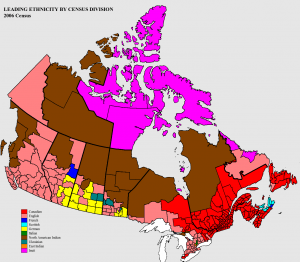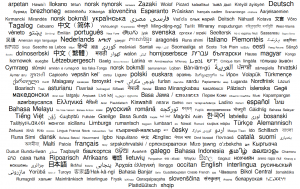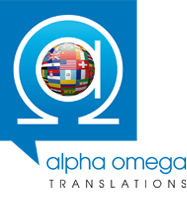By Sarah-Claire Jordan

 Most of the time when we think about Native American languages, we immediately start listing off all of the indigenous languages of the U.S., forgetting that Native American can also refer to the native peoples of any of the countries in the Americas. This includes Canada, a country that many U.S. citizens don’t think about very often, despite the fact that it is just to the north.
Most of the time when we think about Native American languages, we immediately start listing off all of the indigenous languages of the U.S., forgetting that Native American can also refer to the native peoples of any of the countries in the Americas. This includes Canada, a country that many U.S. citizens don’t think about very often, despite the fact that it is just to the north.
Canada has its own indigenous peoples, but does share some with the U.S., as they occupied the land before any arbitrary national borders were created by the government. The name “Canada” is actually of indigenous origin, coming from a St. Lawrence Iroquoian word, “kanata”, that means settlement or village. That being said, it’s no wonder that there would be a great deal of indigenous languages spoken still in Canada. Here are the four most common ones:
1. Cree
Cree is the most common indigenous language in Canada, with over 100,000 speakers. However, it only has status as an official language in the Northwest Territories despite being spoken all across the country. It is in the Algonquian language family and is thought to have diverged from Proto-Algonquian some 2000 or so years ago. Cree is made up of many dialects that operate on a dialect continuum.
2. Inuktitut
Inuktitut, also called Eastern Canadian Inuit, is an Inuit language and the second most common indigenous language in Canada. It can be heard in every part of the country that is north of the tree line, as well as parts of Quebec, Newfoundland and Labrador, and Manitoba. There are four main dialects of Inuktitut depending on where it is spoken. One of these dialects is only spoken in Greenland, and is often confused with a dialect of Greenlandic.
3. Ojibwe
The third most common Canadian indigenous language is also an Algonquian language, and is native to the U.S. as well. Some call it Chippewa or Otchipwe, and most of the dialects of it have local names and different writing systems as well. Ojibwe is still going strong, with no signs of impending language death at all. There is even an immersion school that teaches children exclusively in Ojibwe, so the language is being passed on to new generations.
4. Montagnais-Naskapi/Innu
The last language on our list is, again, an Algonquian language. It is closely related to Cree, so much so that it is considered part of the Cree dialect continuum. However, it still gets to have status as its own language, and it gained some much needed exposure thanks to the folk rock Innu duo Kashtin that became popular in the 80s. Kashtin wrote and performed music almost exclusively in the Innu language.
As you can see, there are still a considerable number of speakers of native languages in Canada. These are only the four most common ones, which means there are many more to discover. Some are faring better than others, but they all form an important part of Canadian cultural heritage. As a translation, interpretation, and desktop publishing services company, Alpha Omega understands better than anyone the importance of spreading knowledge of and preserving these indigenous languages.
For an overview of our translation expertise, visit our telephone interpreting service page



